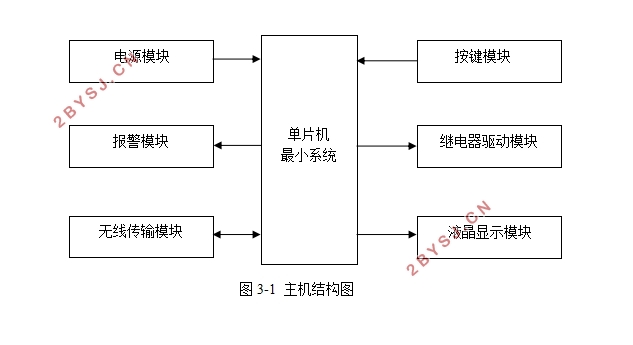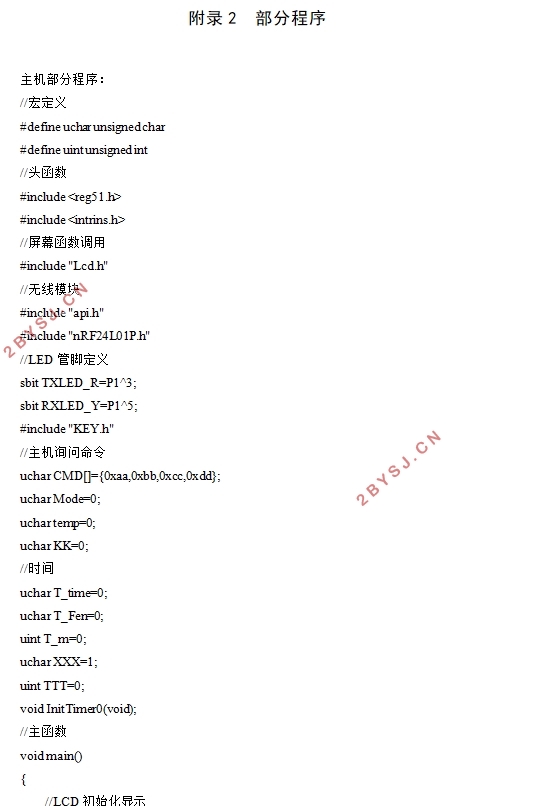基于单片机的智能大棚控制系统的设计
无需注册登录,支付后按照提示操作即可获取该资料.
基于单片机的智能大棚控制系统的设计(论文12000字)
摘要:本设计运用以STC89C52单片机为核心的控制系统,对温室大棚内的温度进行有效控制,建设一个自动化的智能大棚。设计的主要内容:监测端的DS18B20温度传感器对大棚内温度进行采集,无线收发模块NRF24L01将所采集的温度信息发送至控制与显示端。控制与显示端可对报警温度的上下限通过按键进行设置,并将温度信息显示在LCD液晶屏上。当温度高出所设置温度上限或低于所设置温度下限时,蜂鸣器报警,相应继电器吸合,驱动相关设备对大棚内温度进行调节。通过以上设计将大棚内的温度控制在合理的范围内,保证了农作物的健康成长,提高了作物产量,同时智能化的控制减轻了人的劳动强度,实现了良好的经济效益。
关键词:单片机;温度监测;无线数据传输;继电器控制。
Intelligent Control System For Greenhouse Based On Single Chip Microcomputer
Abstract:Greenhouse agriculture is an important part of modern agriculture, it can provide a good growth environment for crops, to avoid the impact of external factors such as weather on crops, and effectively improve the yield of crops. This design uses the STC89C52 microcontroller as the core of the control system to control the temperature in the greenhouse effectively, to build an automated intelligent greenhouse.The main content of the design is: DS18B20 temperature sensor at the monitoring end collects the temperature in the greenhouse, and the wireless transceiver module NRF24L01 transmits the collected temperature information to the control and display terminal. The control and display terminal can set the upper and lower limits of the alarm temperature by the button, and display the temperature information on the LCD LCD screen. When the temperature is higher than the set temperature limit or lower than the set temperature limit, the buzzer alarm, the corresponding relay pull, drive related equipment to adjust the temperature inside the greenhouse.Through the above design, the temperature inside the greenhouse control in a reasonable range, to ensure the healthy growth of crops, improve crop yield, and intelligent control reduces labor intensity, achieve good economic benefits.
Keywords: SCM; temperature monitoring; wireless data transmission; relay control.


目 录
第1章 引言...............................................1
1.1课题背景..............................................................1
1.2课题的内容及意义......................................................1
第2章 国内外现状.........................................1
2.1国内现状..............................................................1
2.2国外现状..............................................................2
2.3所存在问题............................................................2
第3章 系统总体方案设计...................................3
3.1系统设计的目标........................................................3
3.2系统方案的确定及框图..................................................3
3.3器件的选择............................................................4
3.3.1单片机的选择....................................................4
3.3.2温度传感器的选择................................................4
3.3.3液晶显示器的选择................................................5
第4章 系统硬件电路的设计.................................5
4.1系统总电路............................................................5
4.2单片机最小系统........................................................6
4.3温度测量电路..........................................................8
4.4无线传输电路..........................................................9
4.5液晶显示电路.........................................................10
4.6继电器控制电路.......................................................13
4.7按键电路.............................................................13
4.8电源电路.............................................................14
4.9报警电路.............................................................14
第5章 系统软件程序的设计................................15
5.1主机模块程序设计.....................................................15
5.2从机模块程序设计.....................................................17
第6章 结果及评论........................................18
总结......................................................22
致谢......................................................23
参考文献..................................................24
附录1 电路原理图..........................................25
附录2 部分程序............................................26
